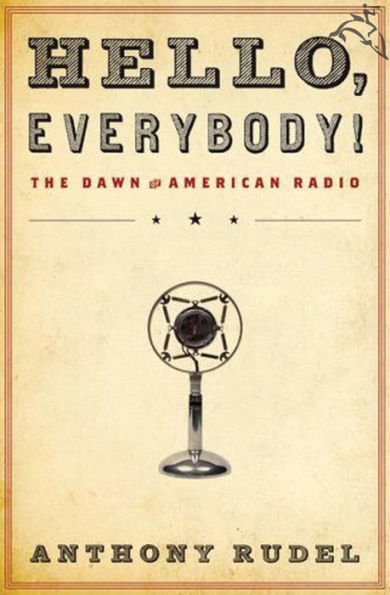Hello, Everybody!: The Dawn of American Radio
“A lively overview” of this pre-internet mass-communication tool and “the entrepreneurs and evangelists, hucksters and opportunists” who flocked to it (Publishers Weekly).
Long before the Internet, another young technology was transforming the way we connect with the world. At the dawn of the twentieth century, radio grew from an obscure hobby into a mass medium with the power to reach millions of people.
When amateur enthusiasts began sending fuzzy signals from their garages and rooftops, radio broadcasting was born. Sensing the medium’s potential, snake-oil salesmen and preachers took to the air, innovating styles of mass communication and entertainment while making bedlam of the airwaves. Into this wild new frontier stepped a young secretary of commerce, Herbert Hoover, whose passion for organization transformed radio into an even more powerful political, cultural and economic force. When a charismatic bandleader named Rudy Vallée created the first on-air variety show and America elected Franklin Delano Roosevelt, who communicated with the public through his famous fireside chats, radio had arrived.
With extensive knowledge, humor, and an eye for outsized characters forgotten by history, Anthony Rudel tells the story of the boisterous years when radio took its place in the nation’s living room.
“Entertaining and informative.” —The Denver Post
“Rudel, with extensive professional radio experience, revels in the enterprising personalities who set up shop on this technological frontier. . . .[And] vividly re-creates the anything-goes atmosphere of the ether’s early days.” —Booklist
"1111545885"
Long before the Internet, another young technology was transforming the way we connect with the world. At the dawn of the twentieth century, radio grew from an obscure hobby into a mass medium with the power to reach millions of people.
When amateur enthusiasts began sending fuzzy signals from their garages and rooftops, radio broadcasting was born. Sensing the medium’s potential, snake-oil salesmen and preachers took to the air, innovating styles of mass communication and entertainment while making bedlam of the airwaves. Into this wild new frontier stepped a young secretary of commerce, Herbert Hoover, whose passion for organization transformed radio into an even more powerful political, cultural and economic force. When a charismatic bandleader named Rudy Vallée created the first on-air variety show and America elected Franklin Delano Roosevelt, who communicated with the public through his famous fireside chats, radio had arrived.
With extensive knowledge, humor, and an eye for outsized characters forgotten by history, Anthony Rudel tells the story of the boisterous years when radio took its place in the nation’s living room.
“Entertaining and informative.” —The Denver Post
“Rudel, with extensive professional radio experience, revels in the enterprising personalities who set up shop on this technological frontier. . . .[And] vividly re-creates the anything-goes atmosphere of the ether’s early days.” —Booklist
Hello, Everybody!: The Dawn of American Radio
“A lively overview” of this pre-internet mass-communication tool and “the entrepreneurs and evangelists, hucksters and opportunists” who flocked to it (Publishers Weekly).
Long before the Internet, another young technology was transforming the way we connect with the world. At the dawn of the twentieth century, radio grew from an obscure hobby into a mass medium with the power to reach millions of people.
When amateur enthusiasts began sending fuzzy signals from their garages and rooftops, radio broadcasting was born. Sensing the medium’s potential, snake-oil salesmen and preachers took to the air, innovating styles of mass communication and entertainment while making bedlam of the airwaves. Into this wild new frontier stepped a young secretary of commerce, Herbert Hoover, whose passion for organization transformed radio into an even more powerful political, cultural and economic force. When a charismatic bandleader named Rudy Vallée created the first on-air variety show and America elected Franklin Delano Roosevelt, who communicated with the public through his famous fireside chats, radio had arrived.
With extensive knowledge, humor, and an eye for outsized characters forgotten by history, Anthony Rudel tells the story of the boisterous years when radio took its place in the nation’s living room.
“Entertaining and informative.” —The Denver Post
“Rudel, with extensive professional radio experience, revels in the enterprising personalities who set up shop on this technological frontier. . . .[And] vividly re-creates the anything-goes atmosphere of the ether’s early days.” —Booklist
Long before the Internet, another young technology was transforming the way we connect with the world. At the dawn of the twentieth century, radio grew from an obscure hobby into a mass medium with the power to reach millions of people.
When amateur enthusiasts began sending fuzzy signals from their garages and rooftops, radio broadcasting was born. Sensing the medium’s potential, snake-oil salesmen and preachers took to the air, innovating styles of mass communication and entertainment while making bedlam of the airwaves. Into this wild new frontier stepped a young secretary of commerce, Herbert Hoover, whose passion for organization transformed radio into an even more powerful political, cultural and economic force. When a charismatic bandleader named Rudy Vallée created the first on-air variety show and America elected Franklin Delano Roosevelt, who communicated with the public through his famous fireside chats, radio had arrived.
With extensive knowledge, humor, and an eye for outsized characters forgotten by history, Anthony Rudel tells the story of the boisterous years when radio took its place in the nation’s living room.
“Entertaining and informative.” —The Denver Post
“Rudel, with extensive professional radio experience, revels in the enterprising personalities who set up shop on this technological frontier. . . .[And] vividly re-creates the anything-goes atmosphere of the ether’s early days.” —Booklist
9.99
In Stock
5
1

Hello, Everybody!: The Dawn of American Radio
416
Hello, Everybody!: The Dawn of American Radio
416
9.99
In Stock

Product Details
| ISBN-13: | 9780547444116 |
|---|---|
| Publisher: | Houghton Mifflin Harcourt |
| Publication date: | 11/01/2017 |
| Sold by: | Barnes & Noble |
| Format: | eBook |
| Pages: | 416 |
| Sales rank: | 34,311 |
| File size: | 548 KB |
About the Author
From the B&N Reads Blog
